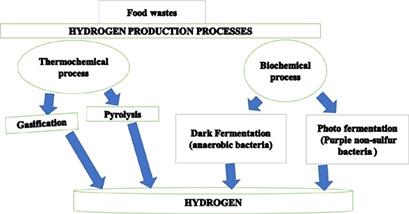当前位置:
X-MOL 学术
›
Chem. Eng. Technol.
›
论文详情
Our official English website, www.x-mol.net, welcomes your feedback! (Note: you will need to create a separate account there.)
Biochemical and Thermochemical Routes of H2 Production from Food Waste: A Comparative Review
Chemical Engineering & Technology ( IF 2.1 ) Pub Date : 2021-04-06 , DOI: 10.1002/ceat.202000526 Sanjeev Yadav 1 , Dharminder Singh 1 , Pravakar Mohanty 2 , Prakash Kumar Sarangi 3
Chemical Engineering & Technology ( IF 2.1 ) Pub Date : 2021-04-06 , DOI: 10.1002/ceat.202000526 Sanjeev Yadav 1 , Dharminder Singh 1 , Pravakar Mohanty 2 , Prakash Kumar Sarangi 3
Affiliation

|
Hydrogen production from food waste by biochemical and thermochemical methods is reviewed herein. Generally, fermentation, a biochemical method, is considered to be more suitable for hydrogen production from food waste, and the performance of fermentation units depends on many factors, e.g., substrate composition, type of pretreatment, reactor configuration, and operating parameters, e.g., organic loading rate, hydraulic retention time, pH, and temperature. Controlling so many factors is tedious, expensive, and results in a slow process. On the other hand, thermochemical methods involve fewer factors and steps, can be much faster and less costly, and can also be used for efficient hydrogen production from food waste. Steam gasification has produced good hydrogen yields from raw food waste.
中文翻译:

从食物垃圾中生产氢气的生化和热化学途径:比较综述
本文综述了通过生化和热化学方法从食物垃圾中生产氢气。通常,发酵这种生化方法被认为更适合从食物垃圾中制氢,发酵装置的性能取决于许多因素,例如底物组成、预处理类型、反应器配置和操作参数,例如,有机负荷率、水力停留时间、pH 值和温度。控制如此多的因素既乏味又昂贵,并且会导致过程缓慢。另一方面,热化学方法涉及的因素和步骤更少,速度更快,成本更低,也可用于从食物垃圾中高效制氢。蒸汽气化已从未加工的食物垃圾中产生了良好的氢气产量。
更新日期:2021-04-06
中文翻译:

从食物垃圾中生产氢气的生化和热化学途径:比较综述
本文综述了通过生化和热化学方法从食物垃圾中生产氢气。通常,发酵这种生化方法被认为更适合从食物垃圾中制氢,发酵装置的性能取决于许多因素,例如底物组成、预处理类型、反应器配置和操作参数,例如,有机负荷率、水力停留时间、pH 值和温度。控制如此多的因素既乏味又昂贵,并且会导致过程缓慢。另一方面,热化学方法涉及的因素和步骤更少,速度更快,成本更低,也可用于从食物垃圾中高效制氢。蒸汽气化已从未加工的食物垃圾中产生了良好的氢气产量。


























 京公网安备 11010802027423号
京公网安备 11010802027423号